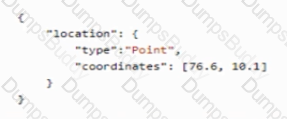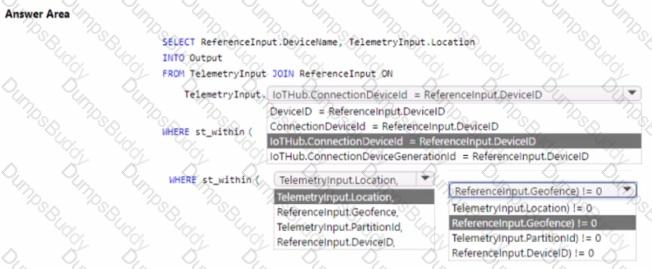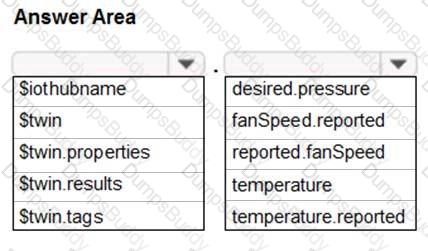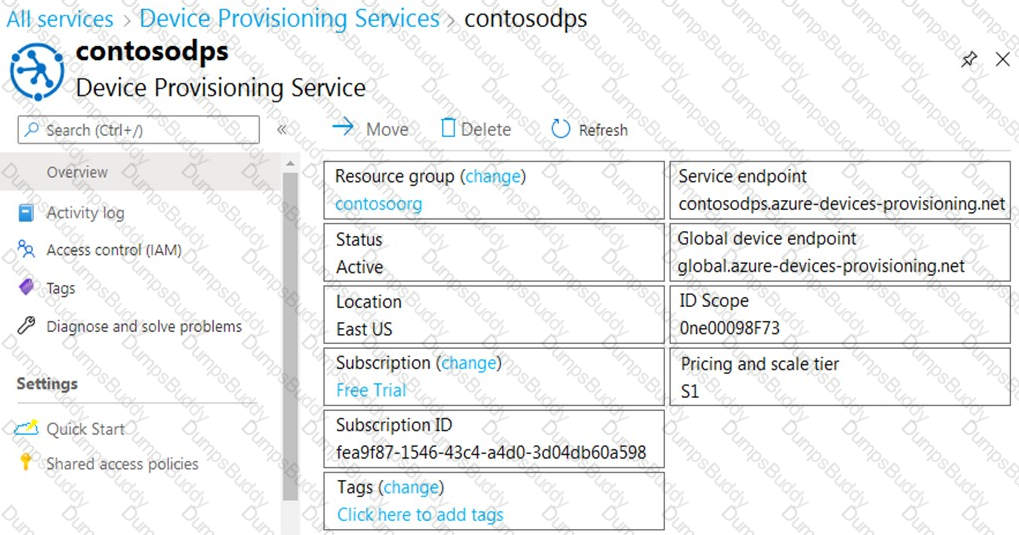You need to design a module deployment strategy that meets the device requirements. What should you create?
You have an Azure IoT solution that includes an Azure IoT Hub named Hub1 and an Azure IoT Edge device named Edge1. Edge1 connects to Hub1.
You need to deploy a temperature module to Edge1. What should you do?
Note: This question is part of a series of questions that present the same scenario. Each question in the series contains a unique solution that might meet the stated goals. Some question sets might have more than one correct solution, while others might not have a correct solution.
After you answer a question in this section, you will NOT be able to return to it. As a result, these questions will not appear in the review screen.
You have an Azure Stream Analytics job that receives input from an Azure IoT hub and sends the outputs to Azure Blob storage. The job has compatibility level 1.1 and six streaming units.
You have the following query for the job.

You plan to increase the streaming unit count to 12.
You need to optimize the job to take advantage of the additional streaming units and increase the throughput.
Solution: You change the query to the following.

Does this meet the goal?
You have an Azure subscription that contains an Azure loT hub named Hub1 and the IoT devices shown in the following table.

You have the automatic device configure rations shown in the following table.

For each of the following statements, select Yes if the statement is true. Otherwise, select No.
NOTE: Each correct selection is worth one point.

You have an Azure 10T hub and an I0T device.
You are developing an loT solution that will generate an alert when the IoT device leaves a geofenced area. The device sends telemetry in the following format.

You create an Azure Stream Analytics job that uses telemetry input from the loT hub and a reference input that contains the data shown in the following table.

How should you complete the Stream Analytics query? To answer, select the appropriate options in the answer area.
NOTE: Each correct selection is worth one point.

You have an Azure subscription named Sub1.
You need to ensure that when a new Azure loT hub is created in Sub1, a warning appears indicating that communication must be allowed only from known networks. The solution must minimize development and administrative effort.
What should you include in the solution?
You have 1,000 devices that connect to a standard tier Azure IoT hub.
All the devices are commissioned and send telemetry events to the built-in IoT Hub endpoint. You configure message enrichment on the events endpoint and set the enrichment value to $twin.tags.ipV4.
When you inspect messages on the events endpoint, you discover that all the messages are stamped with a string of "$twin.tags.ipV4".
What are two possible causes of the issue? Each Answer presents a complete solution.
NOTE: Each correct selection is worth one point.
You create a new IoT device named device1 on iothub1. Device1 has a primary key of Uihuih76hbHb.
How should you complete the device connection string? To answer, select the appropriate options in the answer area.
NOTE: Each correct selection is worth one point.

You need to use message enrichment to add additional device information to messages sent from the IoT gateway devices when the reported temperature exceeds a critical threshold.
How should you configure the enrich message values? To answer, select the appropriate options in the answer area.
NOTE: Each correct selection is worth one point.

Note: This question is part of a series of questions that present the same scenario. Each question in the series contains a unique solution that might meet the stated goals. Some question sets might have more than one correct solution, while others might not have a correct solution.
After you answer a question in this section, you will NOT be able to return to it. As a result, these questions will not appear in the review screen.
You have an Azure IoT solution that includes an Azure IoT hub, a Device Provisioning Service instance, and 1,000 connected IoT devices.
All the IoT devices are provisioned automatically by using one enrollment group.
You need to temporarily disable the IoT devices from connecting to the IoT hub.
Solution: You disconnect the Device Provisioning Service from the IoT hub.
Does this meet the goal?
You are configuring a production environment for an Azure IoT solution.
You plan to deploy 1,000 IoT devices. Each device will send one device-to-cloud message every hour. Each message will be 4 KB.
You need to deploy an Azure IoT hub that will support the IoT device deployment. The solution must meet the following requirements:
What should you deploy?
You are writing code to provision IoT devices by using the Device Provisioning Service.
Which two details from the Overview blade of the Device Provisioning Service are required to provision a new IoT client device? To answer, select the appropriate detail in the answer area.
NOTE: Each correct selection is worth one point.

You need to recommend a solution to keep device properties synced to IoT Hub. The solution must minimize data loss caused by the connectivity issues.
What should you include in the recommendation?
You plan to deploy Azure Time Series Insights.
What should you create on iothub1 before you deploy Time Series Insights?
You need to store the real-time alerts generated by Stream Analytics to meet the technical requirements.
Which type of Stream Analytics output should you configure?
During the POV phase, telemetry from IoT Hub stops flowing to the hot path. The cold path continues to work.
What should you do to restore the hot path?
You need to configure Stream Analytics to meet the POV requirements.
What are two ways to achieve the goal? Each Answer presents a complete solution.
NOTE: Each correct selection is worth one point.
During the POV phase, you connect a device to IoT Hub and start sending telemetry messages.
You need to verify the content of the messages received by IoT Hub during the POV phase.
What should you use?
You need to add Time Series Insights to the solution to meet the pilot requirements.
Which three actions should you perform in sequence? To answer, move the appropriate actions from the list of actions to the answer area and arrange them in the correct order.

You need to recommend the format of telemetry messages to meet the POV requirements.
What should you recommend?
You have an Azure subscription named Sub1 that contains five Azure loT hubs in the basic tier.
You assign an Azure policy named Policy! to Subl. Policy 1 ensures that when an loT hub is deployed, a pnvate endpoint is deployed for the loT hub.
You need to ensure that Policyl is applied to the existing loT hubs. The solution must minimize administrative effort.
What should you do?
You have an Azure subscription that contains an Azure loT hub named Hubl and an Azure loT Edge device named Devicel.
You need to configure Devicel to operate in extended offline mode and to support modifying the configuration of modules deployed to Device! while the device is offline.
Solution: From Microsoft Visual Studio Code, you modify the deployment manifest and you configure the address of the localhost for the container registry in the runtime settings of edgeAgent. You deploy the manifest to Device1, and then you restart the device.
Does this meet the goal?
You have sites that contain loT devices as shown in the following table.

You have an Azure subscription.
You need to create the Azure loT Edge devices shown in the following table.

Which type of gateway pattern should you use for each loT Edge device? To answer, drag the appropriate gateway pattern types to the correct devices. Each pattern type may be used once, more than once, or not at all. You may need to drag the split bar between panes or scroll to view content.
NOTE: Each correct selection is worth one point.

You have an Azure IoT hub.
You need to check whether the IoT hub was affected by an outage.
What should you select in the Azure portal? To answer, select the appropriate option in the answer area.
NOTE: Each correct selection is worth one point.
You have an Azure loT solution that contains an Azure loT Edge device.
You need to perform the following tasks on the device:
• Collect all the logs from the device.
• Identify issues with the config file and the container engine that prevent the device from connecting to the cloud.
• Verify that the loT Edge runtime can access ports on the device, and that all the loT Edge components can connect to an Azure loT hub.
Which command should you use to perform each task? To answer, drag the appropriate commands to the correct tasks. Each command may be used once, more than once, or not at all. You may need to drag the split bar between panes or scroll to view content.
NOTE: Each correct selection is worth one point.

Note: This question is part of a series of questions that present the same scenario. Each question in the series contains a unique solution that might meet the stated goals. Some question sets might have more than one correct solution, while others might not have a correct solution.
After you answer a question in this section, you will NOT be able to return to it. As a result, these questions will not appear in the review screen.
You have an Azure IoT solution that includes an Azure IoT hub and an Azure IoT Edge device.
You plan to deploy 10 Bluetooth sensors. The sensors do not support MQTT, AMQP, or HTTPS.
You need to ensure that all the sensors appear in the IoT hub as a single device.
Solution: You configure the IoT Edge device as an IoT Edge identity translation gateway. You configure the sensors to connect to the device.
Does this meet the goal?
You are developing an Azure IoT solution for a shipping company. The company’s ships will have sensors used for predictive maintenance. Some sensor devices will be MQTT-capable, and others will use Modbus.
Each ship has an internet connection that is available only when the ship is docked.
You create an Azure IoT hub.
You need to implement an IoT solution that uses Azure IoT Edge.
What should you do?
Note: This question is part of a series of questions that present the same scenario. Each question in the series contains a unique solution that might meet the stated goals. Some question sets might have more than one correct solution, while others might not have a correct solution.
After you answer a question in this question, you will NOT be able to return to it. As a result, these questions will not appear in the review screen.
You have an Azure IoT solution that includes an Azure IoT hub, a Device Provisioning Service instance, and 1,000 connected IoT devices.
All the IoT devices are provisioned automatically by using one enrollment group. You need to temporarily disable the IoT devices from the connecting to the IoT hub.
Solution: From the Device Provisioning Service, you disable the enrollment group, and you disable device entries in the identity registry of the IoT hub to which the IoT devices are provisioned.
Does the solution meet the goal?